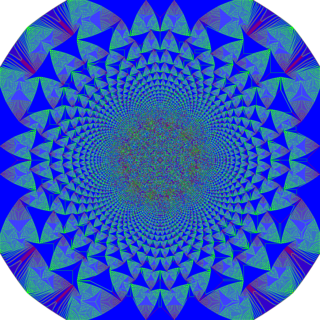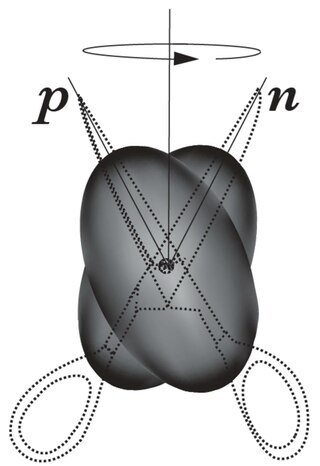
Self-organized criticality (SOC) is a property of dynamical systems that have a critical point as an attractor. Their macroscopic behavior thus displays the spatial or temporal scale-invariance characteristic of the critical point of a phase transition, but without the need to tune control parameters to a precise value, because the system, effectively, tunes itself as it evolves towards criticality.
Per Bak was a Danish theoretical physicist who coauthored the 1987 academic paper that coined the term "self-organized criticality."

The Bak–Sneppen model is a simple model of co-evolution between interacting species. It was developed to show how self-organized criticality may explain key features of the fossil record, such as the distribution of sizes of extinction events and the phenomenon of punctuated equilibrium. It is named after Per Bak and Kim Sneppen.
In physics, the Tsallis entropy is a generalization of the standard Boltzmann–Gibbs entropy. It is proportional to the expectation of the q-logarithm of a distirbution.
In the study of complex networks, assortative mixing, or assortativity, is a bias in favor of connections between network nodes with similar characteristics. In the specific case of social networks, assortative mixing is also known as homophily. The rarer disassortative mixing is a bias in favor of connections between dissimilar nodes.
In a standard superconductor, described by a complex field fermionic condensate wave function, vortices carry quantized magnetic fields because the condensate wave function is invariant to increments of the phase by . There a winding of the phase by creates a vortex which carries one flux quantum. See quantum vortex.
Ferromagnetic superconductors are materials that display intrinsic coexistence of ferromagnetism and superconductivity. They include UGe2, URhGe, and UCoGe. Evidence of ferromagnetic superconductivity was also reported for ZrZn2 in 2001, but later reports question these findings. These materials exhibit superconductivity in proximity to a magnetic quantum critical point.
Dante R. Chialvo is a professor at Universidad Nacional de San Martin. Together with Per Bak, they put forward concrete models considering the brain as a critical system. Initial contributions focussed on mathematical ideas of how learning could benefit from criticality. Further work provided experimental evidence for this conjecture both at large and small scale. He was named Fulbright Scholar in 2005 and elected as a Fellow of the American Physical Society in 2007 and as Member of the Academia de Ciencias de America Latina in 2022.
Heavy fermion superconductors are a type of unconventional superconductor.
The Aharonov–Casher effect is a quantum mechanical phenomenon predicted in 1984 by Yakir Aharonov and Aharon Casher, in which a traveling magnetic dipole is affected by an electric field. It is dual to the Aharonov–Bohm effect, in which the quantum phase of a charged particle depends upon which side of a magnetic flux tube it comes through. In the Aharonov–Casher effect, the particle has a magnetic moment and the tubes are charged instead. It was observed in a gravitational neutron interferometer in 1989 and later by fluxon interference of magnetic vortices in Josephson junctions. It has also been seen with electrons and atoms.
The Vicsek model is a mathematical model used to describe active matter. One motivation of the study of active matter by physicists is the rich phenomenology associated to this field. Collective motion and swarming are among the most studied phenomena. Within the huge number of models that have been developed to catch such behavior from a microscopic description, the most famous is the model introduced by Tamás Vicsek et al. in 1995.

Scissors Modes are collective excitations in which two particle systems move with respect to each other conserving their shape. For the first time they were predicted to occur in deformed atomic nuclei by N. LoIudice and F. Palumbo, who used a semiclassical Two Rotor Model, whose solution required a realization of the O(4) algebra that was not known in mathematics. In this model protons and neutrons were assumed to form two interacting rotors to be identified with the blades of scissors. Their relative motion (Fig.1) generates a magnetic dipole moment whose coupling with the electromagnetic field provides the signature of the mode.

Antonio Helio de Castro Neto is a Brazilian-born physicist. He is the founder and director of the Centre for Advanced 2D Materials at the National University of Singapore. He is a condensed matter theorist known for his work in the theory of metals, magnets, superconductors, graphene and two-dimensional materials. He is a distinguished professor in the Departments of Materials Science Engineering, and Physics and a professor at the Department of Electrical and Computer Engineering. He was elected as a fellow of the American Physical Society in 2003. In 2011 he was elected as a fellow of the American Association for the Advancement of Science.
In statistical mechanics and condensed matter physics, the Kovacs effect is a kind of memory effect in glassy systems below the glass-transition temperature. A.J. Kovacs observed that a system’s state out of equilibrium is defined not only by its macro thermodynamical variables, but also by the inner parameters of the system. In the original effect, in response to a temperature change, under constant pressure, the isobaric volume and free energy of the system experienced a recovery characterized by non-monotonic departure from equilibrium, whereas all other thermodynamical variables were in their equilibrium values. It is considered a memory effect since the relaxation dynamics of the system depend on its thermal and mechanical history.

Alexander Avraamovitch Golubov is a doctor of physical and mathematical sciences, associate professor at the University of Twente (Netherlands). He specializes in condensed matter physics with the focus on theory of electronic transport in superconducting devices. He made key contributions to theory of Josephson effect in novel superconducting materials and hybrid structures, and to theory of multiband superconductivity.
Tin-Lun "Jason" Ho is a Chinese-American theoretical physicist, specializing in condensed matter theory, quantum gases, and Bose-Einstein condensates. He is known for the Mermin-Ho relation.
Christopher John Pethick is a British theoretical physicist, specializing in many-body theory, ultra-cold atomic gases, and the physics of neutron stars and stellar collapse.
Dov I. Levine is an American-Israeli physicist, known for his research on quasicrystals, soft condensed matter physics, and statistical mechanics out of equilibrium.
Turbulent phenomena are observed universally in energetic fluid dynamics, associated with highly chaotic fluid motion involving excitations spread over a wide range of length scales. The particular features of turbulence are dependent on the fluid and geometry, and specifics of forcing and dissipation.
Elbio Rubén Dagotto is an Argentinian-American theoretical physicist and academic. He is a distinguished professor in the department of physics and astronomy at the University of Tennessee, Knoxville, and Distinguished Scientist in the Materials Science and Technology Division at the Oak Ridge National Laboratory.




